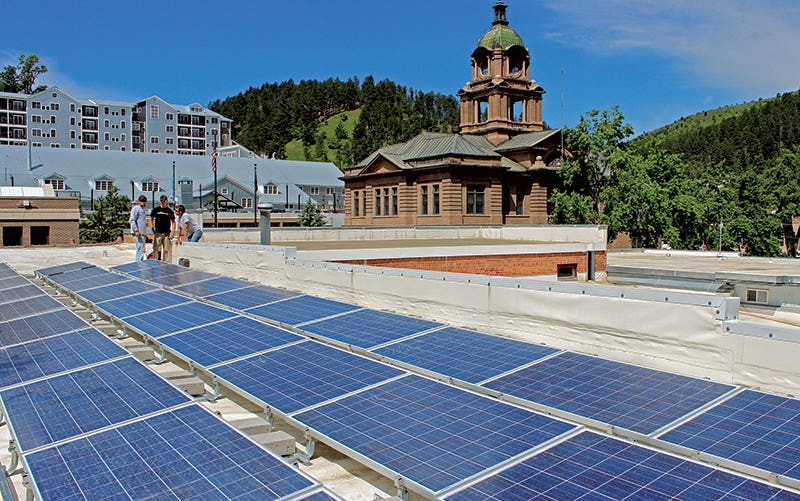
Restoration & Renovation
Historic Building in Deadwood, SD, Installs Sun Power


By Martha McDonald
The town of Deadwood, SD, has a long and colorful history in the American West. It all started in 1874 when General George Armstrong Custer led an expedition to the Black Hills territory owned by the Lakota and discovered gold. This led to the founding of Deadwood in 1876 and within six months the population reached approximately 4,800. It soon became known as a lawless mining town. Many years later, in 1961, the entire city of Deadwood was named a National Historic Landmark District, citing it as "one of the most significant collections of historic structures in South Dakota."
Today the population of Deadwood is less than 1,300 and the town is known for its casinos. And, a new chapter has arrived. The TDG Communications building has become the first structure in the historic center to add solar panels. The installation was heartily supported by the town's Historic Preservation Commission, and the entire process was completed in a very short time, without the supervision of an architect.
Built in 1880, the two-story building at 93 Sherman St. was originally a dentist office and millinery store. It became a hotel for a while, and then in the 1920s, it was remodeled by Frank Merritt into a grocery store. TDG Communications acquired it in 2002.
An advertising agency, web design, public relations and marketing firm, TDG is owned and run by Dustin Floyd and Monte Amende. "I take historic preservation seriously, yet I'm a big supporter of alternative energy," says Dustin Floyd, agency manager and partner at TDG. (He also goes by the title of Benevolent Overlord and he drives a Chevy Volt.) "We weren't sure we could do this, but working with GenPro and the Deadwood Historic Preservation Office, it became clear that historic preservation and solar technology can be compatible.
The project was launched when a former TDG employee went to work for Piedmont, SD-based GenPro. The two companies decided to work out a trade arrangement: TDG got solar panels and GenPro got advertising and promotion services. "My business partner and I were thrilled with the idea," says Floyd. "We really wanted to get involved in alternative energy, even if it wasn't a trade-out.
"People are a bit distrustful of alternative energy"
"This is coal country, but renewable is starting to make inroads." GenPro originally sold wind installations, but switched to solar. The firm does a lot of rural installations, such as solar for water pumps for livestock and crops.
"The entire city is a landmark," says Floyd. "Everyone is proud of it. So we had to go through the Historic Preservation Commission. They were very supportive. The panels have a low profile so you can't see them from the street. We also showed them what it would look like from above, but the preservation officer wasn't concerned; there are huge AC units on roofs of other buildings."
Thirty solar panels cover approximately half of the roof, and they are not attached to the building. Instead, they float on cinder blocks. "We decided that we wouldn't bolt the support structure directly into the building," Floyd notes. "This keeps the roof intact. It was a simple process. Installation only took about 2½ days to get it up and running."
"Once the sun creates the DC energy, panels are strung together to create the desired DC voltage for the inverter. The inverter takes the DC voltages and converts it to alternating current energy that matches the grid power from the utility company," Tim Tesslink from GenPro Energy Solutions explains, noting that each panel is 235 watts in rated peak power.
What this all means is that the solar panels will supply about three-quarters of the electric power needed to operate the historic building on an annual basis. "This isn't a big system," says Floyd. "We are a small office, about 4,000 sq.ft., with 12 people in the building. It's a long narrow building, 100 ft. long 25 ft. wide."
Up and running since June, the system draws from the grid for air conditioning needs, but during the rest of the year, TDG expects to feed extra power back into the grid.
"I hope others will follow," says Floyd. "There is a lot of potential in historic districts where you have a lot of flat-roof historic buildings."








